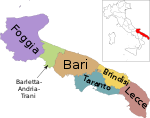Province of Brindisi
Province of Brindisi | ||
|---|---|---|
 | ||
|
ISTAT 074 | | |
The province of Brindisi (Italian: provincia di Brindisi) is a province in the Apulia region of Italy. Its capital is the city of Brindisi. It has an area of 1,839 square kilometres (710 sq mi) and a total population of 401,652 (2013).[2]
Geography
The Province of Brindisi is situated in southeastern Italy, extending for 1,839 square kilometres (710 sq mi), the second smallest province in the region after the
The province, according to the Geological Map of Italy, prepared by the
Demography
In 1861, the province had a total population of 114,790 which grew steadily until 2001 when there were 402,422 inhabitants.[8] It has been more or less static since 2002 when there were 401,534 inhabitants, rising to 403,163 in 2010 but falling again to 401,867 in 2011.[9] In 2010, only 7,437 foreigners (1.8% of the total) resided in the province.[10]
Main comuni
There are 20
| Commune | Inhabitants |
|---|---|
| Brindisi | 87,141 |
| Fasano | 39,711 |
| Francavilla Fontana | 36,349 |
| Ostuni | 31,197 |
| Mesagne | 26,845 |
| San Vito dei Normanni | 19,819 |
| Ceglie Messapica | 19,194 |
| Carovigno | 17,120 |
Oria
|
15,094 |
| Latiano | 14,513 |
| San Pietro Vernotico | 13,684 |
| Cisternino | 11,600 |
| Villa Castelli | 10,640 |
| Torre Santa Susanna | 10,601 |
| San Pancrazio Salentino | 10,289 |
| Erchie | 8,671 |
| San Donaci | 6,768 |
| San Michele Salentino | 6,372 |
| Torchiarolo | 5,419 |
Economy
Surrounded by vineyards, artichoke and olive groves,[11] the city of Brindisi is a major sailing port for the southern part of Italy. In modern times, the province has experienced a process of change in its economic structure, with a progressive decrease in the weight of industry and growth of the tertiary sector. A significant increase in tourism, due to a good infrastructure has been witnessed, as well as the growth of its artistic and culinary assets.[12]
In 2011, the principal sectors of activity in the province were commerce (30%), agriculture (27%) and construction (13%), together representing 70% of the economy. The number of enterprises rose to a peak of 38,435 in 2005 but thereafter fell to 37,304 in 2011. Of these, 8,453 were active in agriculture, mainly in crop production with small percentages in the areas of livestock, agricultural support and mixed farming.[13]
Tourism
From the beginning of the 1980s to the end of the 1990s the Port of Brindisi was the starting point for tourists who passed from Italy to Greece.[citation needed] Subsequently, the tourist demand became increasingly strong also in the rest of the province of Brindisi.[citation needed] Beaches include the Torre Guaceto and the Ostuni beaches. In addition to its beaches, Ostuni is noted for its citadel, city walls, cathedral, and numerous mansions and is one of the main tourist attractions in the province.[14] Another city noted for its tourism is Oria, which includes a 13th-century castle built by Frederick II, cathedral, and Jewish history.[15]
References
- ^ Regions and Cities > Regional Statistics > Regional Economy > Regional Gross Domestic Product (Small regions TL3), OECD.Stats. Accessed on 16 November 2018.
- ^ "Statistiche". Istituto Nazionale di Statistica. Retrieved 28 September 2014.
- ISBN 978-88-6040-798-6.
- ISBN 978-88-464-7818-4.
- ^ Google (28 September 2014). "Province of Brindisi" (Map). Google Maps. Google. Retrieved 28 September 2014.
- ^ Carta geologica d'Italia, Brindisi (in Italian), Istituto Superiore per la Protezione e la Ricerca Ambientale, 1976
- ISBN 978-0-203-93458-6.
- ^ "Popolazione Provincia di Brindisi 1861-201" (in Italian). Comuni-Italiani. Retrieved 29 September 2014.
- ^ "Bilancio Demografico Provincia di Brindisi" (in Italian). Comuni-Italiani.it. Retrieved 29 September 2014.
- ^ "Provincia di Brindisi - Cittadini Stranieri" (in Italian). Comuni-Italiani.it. Retrieved 29 September 2014.
- ^ "Brindisi". Italia.it. Archived from the original on 9 October 2014. Retrieved 28 September 2014.
- ^ "Phase II Urban Pilot Projects BRINDISI, ITALY". European Commission. Retrieved 28 September 2014.
- ^ "Rapporto della Provincia di Brindisi 2012" (PDF) (in Italian). Camera di Commercio Brindisi. Retrieved 29 September 2014.
- ^ "Da vedere a Ostuni" (in Italian). gopuglia.it. Retrieved 20 September 2014.
- ^ "Provincia di Brindisi" (in Italian). Pugliaturismo.com. Retrieved 29 September 2014.


